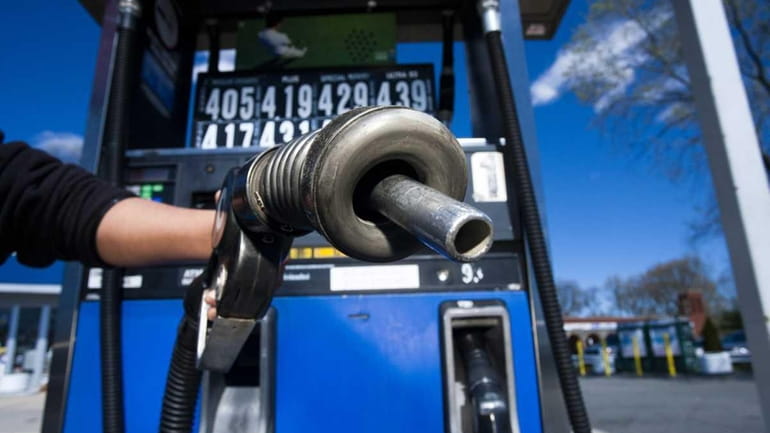Holiday weekend gas prices on the rise

A gas pump and hose at Performance Fuels in Hauppauge. (April 5, 2012) Credit: Heather Walsh
Holiday travelers this weekend will find gasoline prices more than 17 percent higher than at Christmastime, and likely headed higher in weeks to come.
Regular gasoline averaged $4.156 a gallon on Long Island Thursday morning, according to the AAA, up 61.5 cents from $3.541 on Dec. 26, though still well short of last year's peak in May and the record of $4.346 set July 8, 2008.
For a two-car household, whose cars travel 38 miles a day and get 20 miles per gallon -- fairly standard assumptions, according to the Long Island Regional Planning Council -- the increase would add up to almost $71 more in gas expenses per month.
Higher gasoline prices leave less money in household budgets for other items, from new clothing to restaurant meals, potentially endangering the economic recovery that appears to be under way based on job growth and improving consumer confidence.
Filling up Thursday in Smithtown, Kathy Mooney, 42, a homemaker from Hauppauge, mother of three young children and wife of a New York City firefighter, said she and her husband are spending more than $500 a month for gas now. "That's ridiculous," she said. To help make up for it, she says, they're skipping some of the pizza and Burger King meals that are popular with the kids.
Carl Larry, president of Oil Outlooks and Opinions Llc, a consulting firm in Irvington, says he wouldn't be surprised to see prices rise by another 45 cents to 60 cents a gallon before they peak for the season. "We have yet to deal with higher summer demand, so these prices can and probably will go up," said Larry.
Most energy experts say the increase in pump prices since Christmas is due mostly to a rise in crude oil prices as improving world economies portend higher energy demand and, most recently, tensions over Iran's nuclear program, which prompted threats by Iran to interrupt oil shipments in the Middle East.
For East Coast motorists, another factor has been investor fears of tight supplies this summer from the closure of two Philadelphia-area refineries last year and plans to close a third that produced gasoline for this area. The three account for about half the Northeast's refining capacity, according to the U.S. Energy Department.
Another refinery that serves this region, located in the Virgin Islands and run by Hess and Venezuela's state-run oil company, closed in February. The closures mandate that gasoline be shipped here by already overtaxed pipelines and over longer distances by more-expensive tankers from locations including Europe.
Compounding those factors have been seasonal shutdowns by refineries to switch from production of winter-grade gasoline to the less-evaporative summer blends required by clean-air laws.
Some drivers blamed President Barack Obama for high gas prices, as have Republican presidential contenders in the primaries.
Marina Ceschini, 56, of Smithtown criticized Obama Thursday and said the weak economy has forced her three grown children to live with her and her husband, and rising gasoline prices are just one more financial burden. Gesturing toward the $4.059 price for regular at a Smithtown gas station, the secretary said, "Something's going to have to change." An attendant pumped $30 into her Buick, raising the gauge from one quarter to only three-quarters full.
John Kilduff, a partner at Again Capital Llc in New York, a hedge fund specializing in energy, says a recent pullback in crude oil prices suggests that gasoline prices this summer won't reach the $5 a gallon level some had feared, as long as the Iranian situation remains stable. The national average Thursday was $3.936 a gallon for regular, the AAA said.
U.S. benchmark crude oil has risen from a recent low in early February of $96.36 a barrel to as high as $109.77, on Feb. 24. It settled Thursday at $103.31 a barrel in New York trading. European crude oil, used to produce much of the gasoline and heating oil consumed on the East Coast, is typically $15 to $20 more expensive.Price increases since the beginning of this year have led to declines in demand for gasoline. MasterCard Inc. says Americans burned an average of almost six percent less gasoline in the past four weeks than a year earlier.
A similar price run-up at this time last year prompted an investigation by the New York State Attorney General's office, which said in a report issued in December2011 that "When gas prices surged past $4 per gallon for regular unleaded in the Spring of 2011, price gouging . . . was not the reason. Instead, analysis showed that gasoline price increases were primarily driven by changes in the price of crude oil, not actions taken by gasoline retailers or wholesalers."
